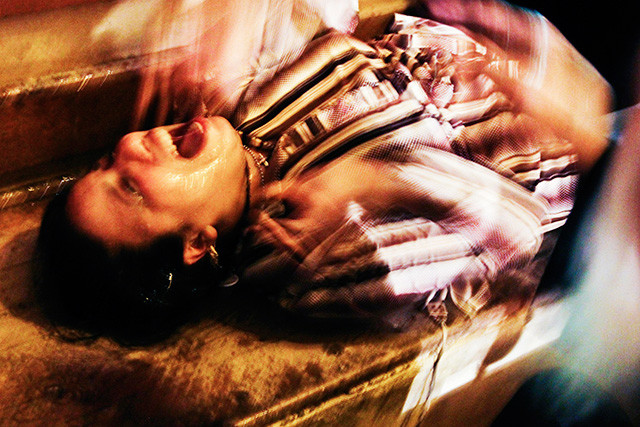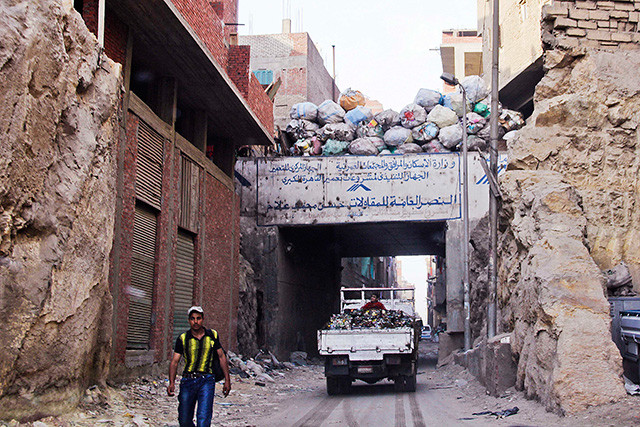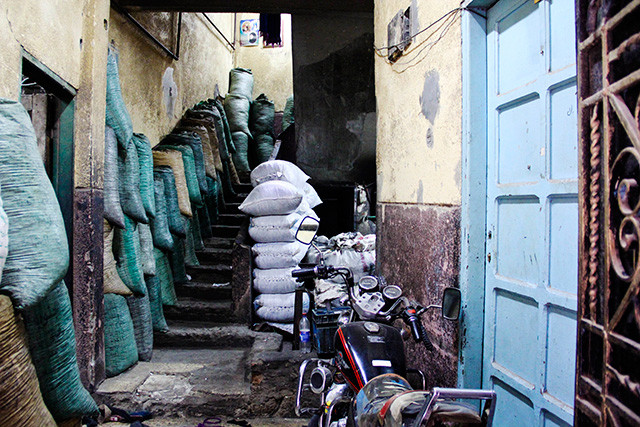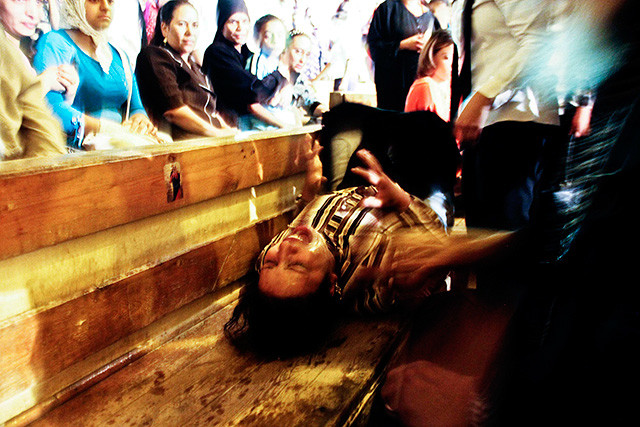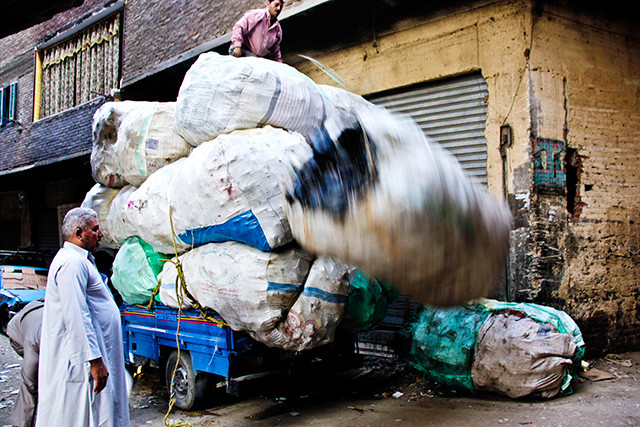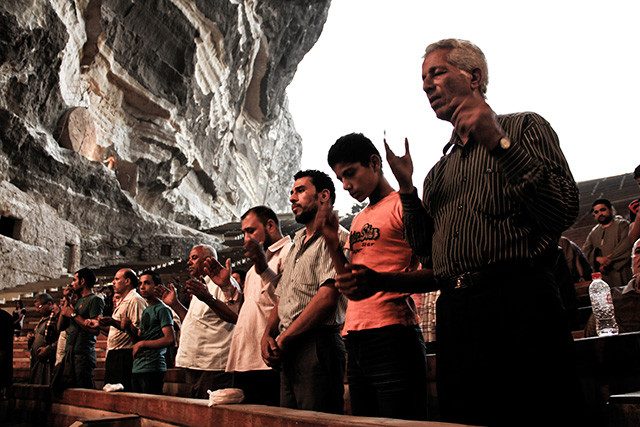(Photos by Omar H. Rahman)
On the day of the first Egyptian presidential election, as millions anxiously stood in line outside polling stations across the country, I was up to my neck in refuse in a place called Garbage City. I was looking for a church where it is rumoured that an Egyptian priest performs mass exorcisms.
Spending any amount of time in Cairo, one learns to cope with the dirt and grime. In a city of 17 million people living on top of each other, you become accustomed to the blanket of smog, car exhaust fumes and dust that inevitably settles on everything. But Garbage City, an urban area of unfinished brick buildings on Cairo’s outskirts, must be in the running for the filthiest place on earth. Imagine a dump transplanted onto a city where people eat, sleep and procreate, and you begin to get an inkling of the reality of Garbage City.
Videos by VICE
In 1969, Egypt’s revolutionary pan-Arab leader, Gamal Abdel Nasser, took all of Cairo’s trash collectors – an occupation traditionally held by Egypt’s marginalised Coptic Christian minority – and consolidated them on the outskirts of Cairo at the foothills of Mount Muqattim, a desert area with no running water, sewage or electricity. What has emerged since is a trash city, literally oozing from windows and doors. Whole families of garbage men, garbage women and garbage children work together sorting and recycling the endless waste. The smell and presence of flies in the sultry weather is enough to make you wretch. You wonder how human beings can live this way until you realise that even a life spent among the trash eventually becomes normal.

Garbage City people are organised and incredibly efficient. Some work only with plastic, others with glass. The trash provides a living for thousands of the residents. The organic matter used to be disposed of by hundreds of pigs, until the government slaughtered them all in a swine flu panic three years ago.
I heard about the mass exorcisms from a photographer friend living in Cairo. The St. Sama’an Church, where they take place, is inside a massive cave on Mount Muqattem. Walking up the hill towards the church, I pass a pile of dead sewer rats, each as big as footballs. St. Sama’an is said to be one of the largest churches in the Middle East. The place, with its stadium seating for 20,000 people, is not unlike the Billy Graham mega churches in the US. There are actually six adjoining churches built into the mountainside, along with numerous frescoes depicting biblical scenes cut into the stone façade. The contrast to the Garbage City wasteland below couldn’t be starker.
The exorcisms are largely kept under wraps. An ageing priest performs them for both Christians and Muslims, a rare thing in a country riven by inter-religious strife. When I was in Cairo last year, after the epic 18-day revolution, there were riots after a rumour went around that a Christian woman who had converted to Islam was being held hostage in a church basement. Several people – both Christians and Muslims – were killed in the ensuing violence and the church was set on fire.
Father Sama’an Ibrahim, the presiding priest, built the Cave Cathedral in stages during the 1980s and 90s for the garbage collectors. He found them living in sin and squalor, without a church of their own, and decided it was his mission to help them. Now in his 70s, Father Sama’an presides over the Garbage City parish, attracting adherents from all over. Many of those who attend the exorcisms are Muslims, eager to interact with the supernatural.

Despite the friendly intermingling of Muslims and Christians, Garbage City has not been immune to the outbreak of sectarian violence that has marred the aftermath of Egypt’s historic revolution. Many of the residents I spoke to have opted to vote for Ahmad Shafiq, a retired air force general linked to the old regime, who provides a sense of stability for Egypt’s Coptic Christian minority.
Inside the compound we meet Magid, a man who helps out at the church. He gives us a rundown of the history of the church and explains what will happen with the exorcisms, “When the priest mentions the name of Jesus, the devil is destroyed. You will see!”
Nearly 2,000 people pack into the creaking wooden pews. Although the architecture is impressive, with a large overhanging rock spanning the entire amphitheatre, the church service is like all church services since time immemorial. That is to say, boring as hell. We sit through nearly two hours of singing and prayer. When night descends on the cave cathedral, I make my way to the front, anticipating that the priest will parade out the crazies and get things started. The lights dim, the music becomes louder. Some of the women in front start crying and swaying, eyes closed in spiritual reverie.

All of a sudden, I hear the howl of a man who sounds like he has been stabbed. The priest – cloaked in black with a long, white beard and gilded cross in hand – is clutching a middle-aged man whose body is convulsing on the bench. The priest takes a handful of holy water and throws it into the man’s face, reciting biblical incantations. The man stops yelling and his eyes roll back into his head.
The priest parts the crowd and makes his way over to a group of women. Ghastly shrieks echo off the cave walls. The priest slaps the women in the face and spits into their mouths. He even spits in water bottles and gives them out to drink. These women appear relieved by this saliva cocktail. After each of them is cured, they are marked by what looks like holy lip-gloss, drawn on their hands and foreheads. Two of the women begin vomiting after the exorcism begins, but, in a matter of minutes, they are miraculously cured. The crowd of spectators, mostly women, claps.
Only moments ago, these people had been normal. Now they were aggressively pulling at my pant leg, begging me to get the priest’s attention to comfort their daughters. It was a circus.
Maybe this is what exorcism is: a way to give comfort to the disturbed, a little bit of spiritual catharsis to clear things out. Our problems are all in our heads anyway, right? The cure is in making us believe that we are ok. And those that see the world through the prism of angels and demons probably need Father Sama’an’s spit more than Dr. Freud’s couch.
The whole thing was over in less than 20 minutes. Afterwards, I asked one of the previously possessed women how she was feeling.
“I feel great,” she said with a huge smile. “Thanks to God.”

